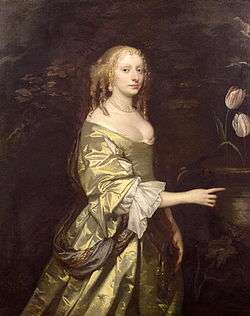Elizabeth Wilbraham

Lady Elizabeth Wilbraham (1632–1705), née Mytton, was a member of the English aristocracy, who traditionally has been identified as an important architectural patron. Recently she is posited to be the first known woman architect, whose work frequently may have been attributed to men. In addition to a dozen family residences and a larger number of churches, as many as 400 buildings may have been designed by her.
Early years
Elizabeth Mytton was born into a wealthy family and, aged 19, married Thomas Wilbraham,[1] heir to the Baronetcy of Wilbraham. They went on honeymoon together, travelling throughout Europe. She made this an opportunity to take an extended architectural study tour.
In the Netherlands Elizabeth Wilbraham met architect Pieter Post,[1] creator of the Dutch baroque style of architecture. She studied the works of Palladio in Veneto, Italy and the Stadtresidenz at Landshut, Germany.[2]
Personal life
Little is known about Wilbraham's private life, but private letters were discovered and passed to the Staffordshire Record Office in 2008. These showed Wilbraham's search for suitable husbands for her daughters, Grace and Margaret. According to the marketing executive of the Weston Park Foundation, "The letters explain the importance of a suitable match within the aristocracy of the day. She was certainly a very strong lady and knew what she wanted and how to get it".[3]
First known woman architect
A 2012 book by historian John Millar claims that Wilbraham is the first known woman architect.[1] Millar says this follows more than 50 years of research into the subject.[2] In 2007 the owners of the stately home, Wotton House, organised a conference to investigate who was the original architect of the building. The conference generated at least two follow-up papers: in 2010 Sir Howard Colvin proposed that John Fitch may have been the original architect, and later the same year, Millar, noting Colvin's paper, proposed Wilbraham as an alternative.[4][5]
During the seventeenth century it was impossible for a woman to pursue a profession and Wilbraham is said to have used male executant architects to supervise construction in her place.[1] She is believed to have designed more than a dozen houses for her family and, because of the inclusion of distinctive and unusual design details, has been put forward by Millar as the designer of 18 London churches (officially attributed to Christopher Wren).[1] Because Wren came late to architecture, Wilbraham has been suggested by Millar as his most likely tutor.[1]
As many as 400 buildings have been suggested by Millar as possible works of Elizabeth Wilbraham. They all generally show similarities with Italian or Dutch architecture.[2] Wilbraham owned a 1663 edition of Palladio's book I Quattro Libri (volume I) and she heavily annotated it.[2]
In the authoritative and encyclopaedic Biographical Dictionary of British Architects 1600-1840 (4th Edn; 2008) by Sir Howard Colvin, however, she is mentioned only once. That notation is as a patroness of architecture.
Notable projects
- Weston Hall, Staffordshire (1671)[6] - sources such as English Heritage attribute the design to Elizabeth Wilbraham, but the executant architect was William Taylor.
- Wotton House, Buckinghamshire (rebuilt 1704-1714) - architect unknown, but Wilbraham or John Fitch have been put forward.[2]
See also
Notes
- 1 2 3 4 5 6 Jay Merrick Elizabeth Wilbraham, the first lady of architecture, The Independent, 16 February 2011. Retrieved 2011-12-06.
- 1 2 3 4 5 John Millar The first woman architect, The Architects' Journal, 11 November 2010. Retrieved 2011-12-06.
- ↑ Rare letters of Weston Park aristocrat donated to public records, The Birmingham Post, 26 November 2008 (archived on thefreelibrary.com). Retrieved 2012-02-02.
- ↑ Colvin's paper was published in the 2010 Georgian Group Journal (Millar 2010)
- ↑ Millar 2010.
- ↑ Weston Hall (photo and listing information), English Heritage Pictures of England. Retrieved 2011-12-10.
References
- Millar, John (11 November 2010). "The first woman architect". The Architects' Journal. External link in
|journal=(help)